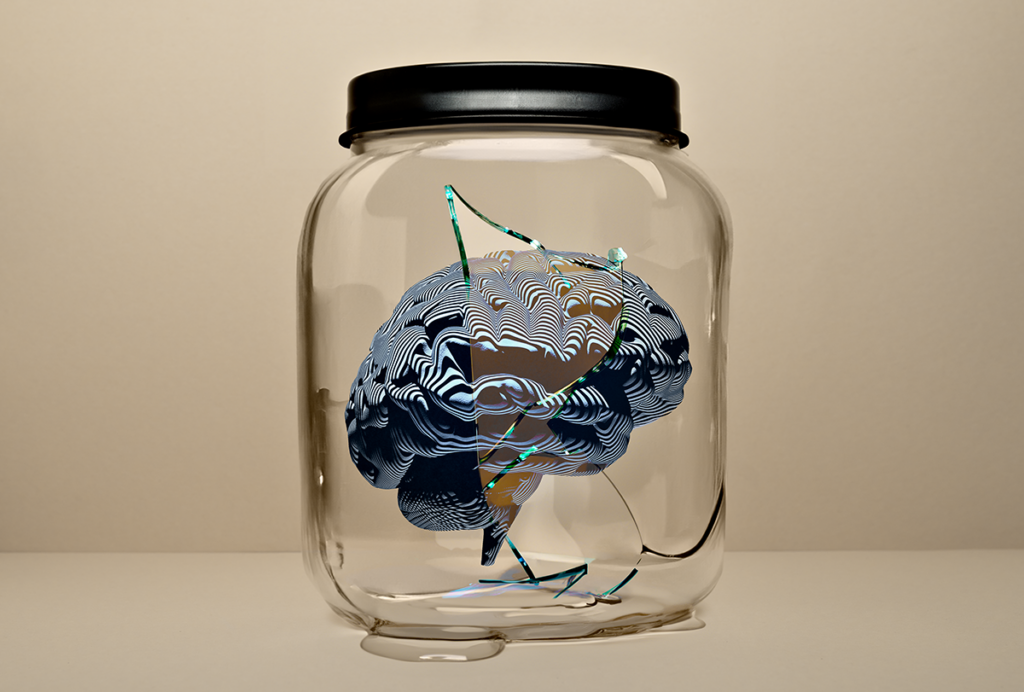Robert Yang was mobbed after his talk. He had just presented results from his company Altera’s “Project Sid” to an audience of neuroscientists and artificial-intelligence researchers at the 2024 NAISys meeting at Cold Spring Harbor Laboratory. So when the opportunity came up to have a follow-up discussion with him for The Transmitter, I jumped at it.
For a little background, the project he presented involved simulating 1,000 virtual agents and setting them free in a Minecraft environment, and then popping back in every once in a while to see how their creations were getting on. Yang’s talk was peppered with funny videos and stories of the fascinating collective behaviors that emerged. (You can watch some of them on YouTube.) But what really got people interested was the serious impression that this could be a viable route to genuine artificial general intelligence (AGI).
Since the arrival of ChatGPT and other large language models (LLMs), we’ve all heard the predictions that AGI is just around the corner. All we need is scale (and the content of the entire internet, along with a few dedicated nuclear power plants). The problem with LLMs, though, is that they manage to seem to simultaneously know everything and not know what any of it means. By being trained on a vast corpus of human writings, they can integrate knowledge on a scale that surpasses any individual human and generate plausible—even insightful—answers to all kinds of questions. This makes it seem like they have an impressive world model—like they have real understanding. But the understanding actually depends on the interpretation of human interlocutors. The system itself doesn’t know what any of the words it says really mean, except in reference to other words. It has only a self-contained world-of-words model—it is humans who connect the referenced concepts to the real world.
The prospects of LLMs developing into real, autonomous AGI, purely by scaling up, thus seem remote. After all, intelligent is as intelligent does, and LLMs don’t do anything. Against the backdrop of the hype around these systems, many have proposed an alternative route to AGI: Start by building simple agents with control systems that allow them to behave adaptively in some environment. And then complexify their cognitive systems to allow them to behave in more sophisticated ways and adapt more flexibly to novel situations—that is, make them more intelligent.
Yang, who closed his lab at the Massachusetts Institute of Technology in December 2023 to focus on Altera, and his colleagues have bypassed this long recapitulation of evolution by combining these approaches. First, they built on prior work that designed agents with a modular cognitive control architecture, incorporating important principles from cognitive science relating to memory consolidation, hierarchical action selection and flexible goal-directed behavior, for example. Second, they included a “top-level controller”—a module with access to information from all the lower-level modules, filtered for salience and importance, as changing situations demand. And third, they’ve connected all of this, for each agent, to an instantiation of ChatGPT.
The result is agents that are (arguably) capable of abstract, symbolic reasoning at a linguistic level, which is now grounded—linked to “real” goings-on in their blocky virtual world. The LLMs are no longer isolated brains-in-a-vat. Now they’re plugged into The Matrix. It’s not just that these agents can move around and pursue goals in this virtual world. They can now reason about those goals. They can think. And they don’t think alone.
Because they have a language model—and the words in that language are now grounded to the world they move in—they can talk to each other and know what they mean. When one agent asks another to “give me a pickaxe,” they both know what “pickaxe” refers to in the world. When one proposes that “we go explore together,” they both know what “exploring” entails in the virtual world. This also means that the experimenters can talk to the agents, prompting them with various goals or ideas and using the amazing role-playing abilities of ChatGPT to encourage all kinds of interesting social dynamics.
These developments raise a host of questions—from the details of the cognitive architecture used to philosophical questions of representation, mind, consciousness, agency and life itself. And, of course, the ethics of playing God with arguably conscious entities—what Yang calls “digital humans”—even if only in a virtual world. The conversation he and I had in January answered some of my technical questions but, if anything, only deepened the philosophical ones.
Watch our conversation or read the transcript.



